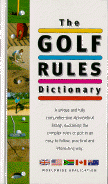The Golf Rules Dictionary (2d edition)
A copy of the Rules of Golf is an occasionally overlooked but nonetheless essential part of a well-equipped golf bag.
For just this purpose, both the Royal and Ancient and the USGA make available handy pocket-size copies of the 34 rules that govern the game.
As most golfers know, however, the Rules don’t always furnish a ready answer to the situations that can arise during a round of golf, whether it’s a friendly match among friends or a full-blown amateur tournament.
Each year, the R & A and the USGA deal with these fact-specific circumstances by issuing separate publications, called the Decisions on the Rules of Golf, to fill in these gaps. At this point, however, the combination of the Decisions and the Rules would match the volume and weight of a college textbook hundreds of pages long.
I like big books as much as any other avid reader, but that doesn’t mean I want to lug one all over the golf course.
Fortunately, Hadyn Rutter did us all a favor, with his colorfully illustrated Golf Rules Dictionary. This compact volume will fit in anyone’s golf bag, and should prove beneficial to both novice and experienced golfers.
Rutter synthesized the Rules and the Decisions to cover the most often occurring situations, and organized the materials into a fairly intuitive, alphabetical format.
The book is called a Dictionary because of the format. It’s actually far more of a guidebook. For example, suppose a player discovers that his ball moved after it had come to rest after a shot. To learn what to do he turns to “Ball Moved When Stationary” in the Dictionary. There he will first see a short description under “What is it?” He then learns to make some Preliminary assessments of the reasons for the move.
Each situation may implicate a different Rule, and Rutter guides the golfer to the appropriate page for each one. These pages include a description of the Basic Rule, the Penalty involved if any, and the Exceptions that may affect the Rule’s application, based on the Rules or the Decisions interpreting them.
Rutter also includes handy diagrams to help the golfer understand the proper way to apply the rules. For example, he provides an overhead rendering of actual golf holes in the sections dealing with Out of Bounds and Lateral Water Hazards that enhance his written explanation.
In addition, Rutter included photographs to further assist the golfer to understand the rules and how they work. Other photographs are interspersed throughout the text for sheer enjoyment, but this book will never be confused with a typical coffee table volume.
The Dictionary should also prove useful for club professionals and tournament committees. Country clubs should keep a copy handy in the pro shop or club library, either for debates at the 19th hole, or for those awkward moments when the club championship may hang in the balance.
The guidance Rutter provides is his own distillation of the Rules and the Decisions. On the other hand, he gained the cooperation of the R & A with his first edition, and the USGA authorized this second edition’s distribution in the United States and Mexico.
It’s also fair to say that Rutter did a good job in simplifying a complex subject, in a format that should help many golfers enjoy the real game of golf.
Review date: February 4, 2001


